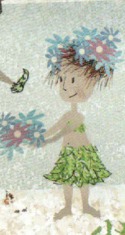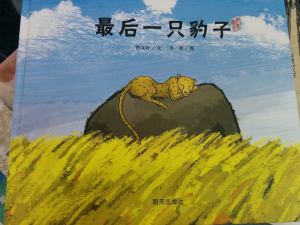There Is a TRIBE of KIDS (capitalization as part of the title/design), written and illustrated by Lane Smith (Stinky Cheeseman, The Happy Hocky Family, It’s a Book, etc.), was published in May, 2016 (two months ago.)
This book has received four starred reviews from major review sources and positive reviews from others. However, the use of the word TRIBE and some of the images on a particular double-page spread toward the end of the book have sparked heated debate (in which I took part) in several online places. A short description and link to each of these reviews (with comments) can be found at the end of this post.
I read and re-read this book many times and have considered all the reviews cited below and many additional comments sprinkled throughout the internet. Finally, I feel that I am ready to share my own take on this book. I must stress that this is but ONE of many potential interpretations of the book which features very few words and delivers most of its “messages” with pictures that can be differently interpreted.
By no means do I want to discount Debbie’s and others’ pain when they face certain images (that they see on the second to last double spread) which definitely trigger strong emotional reactions from past and personal experiences. (My own triggers are seeing erroneously attributed so-called Chinese cultures or imageries and boy do those get me seeing red!)
So here it is,
Fairrosa’s Interpretation of the Double Spread in There Is a TRIBE of KIDS:
I must confess that my initial reaction to the word TRIBE in the title was a skeptical one: how would it be used in the book? to indicate some relations to Native American cultures? to indicate something primitive? When I finally read through the book (many times over,) I realized that, as Debbie Reese and many reviewers pointed out, it is a play on word. Tribe is a collective noun for a group of “young goats” (kids) and Tribe is also a collective noun for many human groups that share the same cultural, geographical, or historical experiences. The word is still used widely. It is used by American Indians as their official group names. It is used by the Jewish people. It is also used by groups who need to bond over their unique identities and experiences, such as the deaf community (as found in Tribes, a play by Nina Raine from 2015.)
In the case of this book, Lane Smith used it to indicate a very specific “kind” of human beings: children. The child protagonist, after mimicking all kinds of animals, finally found his own “tribe.” The text is all in past tense — until the very last spread which is in present tense, proclaiming the currency and the universality of childhood.
Here is my interpretation of the second to last spread accompanying the text, There was a TRIBE of KIDS (note the past tense!)

(reproduced with permission from Roaring Brooks Press)
Since our child protagonist is not in this picture, so unlike the previous encounters, we don’t see him mimic or play act. We see this child (looking a bit like Burt in Mary Poppins, doesn’t he?) welcoming the new child (our protagonist, off page, unseen) into a TRIBE.

We, readers, along with the child protagonist, observe the scene with keen interest:
A TRIBE of kids from around the world and from both yesteryears and now, dressed much like our protagonist (in leaves, branches, and flowers,) being themselves and playing like all children might:
We watch, as they
swing, eat and play with their food,



collect seashells and flowers,


play balls, crawl, balance, dance,




scout, explore,


take care of a younger sibling,

dress up like an adult (a princess, a king, a judge?)



give a hug,

dangle, slide,



model, run (like an olympian with a torch,)


hide, and seek.




What I do not observe is the child protagonist attempting to mimic any of these KIDS, as if these are roaming animals. I also don’t see the “wildness” linked to a colonial sense of the word TRIBE (as stated by Minh C. Le and as troubling to others). I see children engaging in regular childlike and childhood activities. And if I were to read this book with a young child, that’s how I would posit it — “Look, do you play hide and seek, just like these kids? Do you pretend to be a king or a princess sometimes? Do you play with your food? Do you love going down the slides or sit on a swing? This makes you part of the TRIBE of all children in the world. You belong with each other and you accept and embrace one another.”
As I pointed out in the beginning of this post, my interpretation is different from some others’ views, including those of Minh C. Le’s, Sam Bloom’s, and Debbie Reese’s. All three wrote thought provoking reviews of this title — and I urge all to read them and take their concerns or potential hurt and mis-use of this book seriously.
Il Sung Na’s ‘The Opposite Zoo,’ and More by Minh C. Le (New York Times)
Le feels that the “juxtaposition of the word ‘tribe’ with the woodland utopia conjured uncomfortable associations,” and a particular image is problematic “in its echoes of the longstanding trope in children’s literature that uses Native imagery or ‘playing Indian’ to signify wildness.”
Reviewing While White: There Is a Tribe of Kids by Sam Bloom (Reading While White)Bloom finds himself in agreement with Le’s take on the book and ponders why all the reviewers for the major publications have given this book such favorable feedback when he sees even more images that are problematic. He posits that perhaps it is due to Lane Smith’s long-time fame and status as a celebrated children’s book creator. He also links to a page delineating the negative associations that the word TRIBE contains from the Teaching Tolerance site. Bloom concludes his essay by strongly indicating that he does not recommend this book. He writes, “If it wasn’t Lane Smith’s name on the front cover, could we more easily see the problems inherent in There Is a Tribe of Kids? I don’t know the answers to these questions, but I do know that this is a book that I personally won’t be sharing with (human) kids.”
Lane Smith’s new picture book: There Is a TRIBE of KIDS (plus a response to Rosanne Parry) by Debbie Reese (American Indians in Children’s Literature)
Reese details the picture book and focuses first on the word play and the repeated pattern of a child going through the natural world, mimicking behaviors of groups of animals, while garbed in leaves. Reese then moves on to discuss the double spread that features a TRIBE of KIDS (children) and the specific images she finds objectionable. She also delineates many counter-points to Rosanne Parry’s review of the book. Reese uses words like “rolling your eyes” and “grinding your teeth” to express how irate she is with Parry’s proposed interpretation of the book’s images.
Rosanne Parry also wrote a blog post in response to Sam’s post: A Tribe of Book Reviewers (Writing in the Rain Blog). Parry writes to share her interpretation of this book and her disagreement with Sam’s take on the book as a reinforced negative portrayal of children “playing Indian.” Parry’s take on this book is in accordance with reviewers who see that there are multiple cultures represented in the book and that the book’s focus is on the importance of a sense of belonging and the warmth of acceptance in every child’s life, regardless of their origins or skin tones. The final “snapshot” seems to encapsulate this sentiment — the kids of pale and dark skin tones locked in a friendly embrace to show their kinship and solidarity:
For those interested, here are links to all four starred reviews:

















































 These thoughts went through my mind as I visited Beijing and the International Book Fair with a focus on the local books published for the Chinese young readers.
These thoughts went through my mind as I visited Beijing and the International Book Fair with a focus on the local books published for the Chinese young readers. The Last of the Panthers shows the devastating scenario of the “last” of many species and there is no uplifting or hopeful ending when our Panther gives up on itself and falls into the perpetual sleep. It is heart wrenching but so effective. A young person reading the simple text and looking at these gorgeous pictures would acutely feel the pang of loss of such majestic animal and might be inspired to be more responsible in caring for our natural world.
The Last of the Panthers shows the devastating scenario of the “last” of many species and there is no uplifting or hopeful ending when our Panther gives up on itself and falls into the perpetual sleep. It is heart wrenching but so effective. A young person reading the simple text and looking at these gorgeous pictures would acutely feel the pang of loss of such majestic animal and might be inspired to be more responsible in caring for our natural world. Another title is the Hat King. A story set during the Sino-Japanese war when the boy and his grandfather (a magician skilled in “hat tricks”) had to endure the deaths of the boy’s parents at the concentration camp and even when they successfully escaped from the camp, they had no house to go back to any more. And that’s how the tale ends. This is a story almost never told to the children in the U.S. It’s powerful and bleak — but it’s also real and full of familiar affection.
Another title is the Hat King. A story set during the Sino-Japanese war when the boy and his grandfather (a magician skilled in “hat tricks”) had to endure the deaths of the boy’s parents at the concentration camp and even when they successfully escaped from the camp, they had no house to go back to any more. And that’s how the tale ends. This is a story almost never told to the children in the U.S. It’s powerful and bleak — but it’s also real and full of familiar affection.
 I posted this to Facebook just now, thinking that it has little to do with Children’s or YA literature so the paragraphs do not belong on this blog. However, when I consider the reason for We Need Diverse Books movement and the imagery of young black males portrayed in some “gritty” modern teen novels, I found myself compelled to post my facebook update here as well:
I posted this to Facebook just now, thinking that it has little to do with Children’s or YA literature so the paragraphs do not belong on this blog. However, when I consider the reason for We Need Diverse Books movement and the imagery of young black males portrayed in some “gritty” modern teen novels, I found myself compelled to post my facebook update here as well: